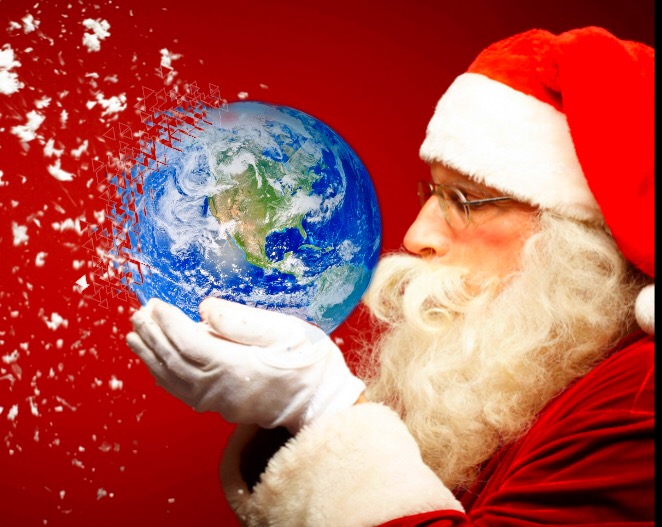342 DAYS TO GO!
E. Delaney
January 17, 2019
“Christmas.” That’s practically all we’ve been hearing since late October. The flashy holiday with its gift giving, Santa Claus, Christmas trees and general good cheer is a colossal deal here in America. Pop stars, movie producers, and stores all flock to cash in on the long, merry season of festivities; we have about a billion Christmas songs and albums, films, merchandise, and branding come in and out of stores and theaters each year.
As Santa, Rudolph, and Dr. Seuss’s Grinch come out to play, classics like A Charlie Brown Christmas, ELF, It’s a Wonderful Life, A Christmas Carol, and many, many more are swept off of shelves and watched yet again by families and individuals all over the nation. When you hear the word, images of reindeer tied to an ornate sleigh soaring through the stars, or children tucked, wide-awake, in their beds, in eager expectation of Mr. Kringle’s arrival.
That’s the mainstream aesthetic of the Christmas holiday, at least. But if you’ve lived outside of the U.S., you may know that other countries and places celebrate the winter holiday in very diverse ways and have their own icons and traditions. Even historically, Christmas was honored in very different ways than we do today. In fact, its origins have virtually nothing to do with the 21st century celebration of it.
While we’re moving about under the warm glow of tiny strings of LED lights, the residents of the Philippines are being dazzled by elaborate, twenty-foot lanterns. Competition to create the most ornate, creative, brilliant lantern in the City of San Fernando, where the enormous lights are shown off, is intense. Red, blue, green, purple, yellow, pink, and gold -there’s no dress code for the festive enormities.
A Christmas horror movie sounds like a major juxtaposition, but if you’ve seen or heard of Krampus, you know it’s all but nonexistent. In fact, Austria’s Christmas has a Halloween-esque side, as the legend of Santa’s devious sidekick, Krampus, is actually a significant part of their tradition. On the otherwise festive day, some people dress up like the horned demon Krampus, who, while Santa Claus is rewarding good children, captures the bad ones and steals them away, punishing them for their naughty behavior. If disobedient American children knew how it was in Austria, they would thank Santa for their lumps of coal.
KFC, Valentine’s Day, Disney, and Christmas – they don’t seem to have much in common, do they? Well, on the other side of the world, all these things are the reason for the Christmas season. On December 25th, Japanese families eat Kentucky Fried Chicken, couples go out to enjoy all of the love-themed deals, and just about everyone flocks to the fantastically decorated Tokyo Disneyland. Japan has a reputation for often being wacky and over-the-top, and their interesting spin on Christmas only supports that implication.
Not too far away, the Aussies are experiencing the most intense heat of the year. That doesn’t stop them from having Christmas spirit. The Australian Santa Claus is often portrayed at wearing a T-shirt and shorts, riding a sleigh tied to white kangaroos. Instead of cozied up in front of a fireplace while snowflakes softly descend outside, Australians may take a vacation to the beach and have a cookout. Despite their unorthodox method of celebration, the Aussies are very enthusiastic about the public holiday.
The origins of this widely and wildly celebrated holiday are often debated, but the debate is predominantly between Paganism and Christianity, the latter generally presiding over the former.
The word “Christmas” traces back to “Christ mass”, or “mass on Christ’s birthday.” The major idea is that “mass” is a shortened version of “messiah,” and some believe that “mass” translates to death. Most believe that the holiday is celebrated in commemoration of the birth of Jesus Christ, which would align with the first definition. Catholics Mass is a crucial event in which they prepare bread and wine like the disciples had the night Jesus was to be executed in order to signify the bond between Christ and the Church, to represent his death on the cross, and to commemorate his rising again with a sense of redemption and deliverance.
“During the first two centuries of Christianity,” according to Britannica, “there was a strong opposition to recognizing birthdays of martyrs or, for that matter, Jesus.” They believed that birthdays were a pagan celebration and were against appropriating those practices. Instead, they celebrated the time of their martyrdom. The Roman holiday dies solis invicti nati, which celebrated the new prominence of the sun as the winter solstice ended and warmer, more prosperous times began, took place on December 25th, and even though Christ’s date of birth was never disclosed, that date is ordinarily accepted as his birthday and celebrated for this reason by Christians everywhere.
Also tracing back to Catholicism is the secular icon of the christmas season: Santa Claus, originally known as Saint Nicolas. The young Catholic bishop and the fat, jolly felon couldn’t be more different, but they were similar in one essential aspect. Saint Nicholas’ parents died when he was quite young, but he used the money he inherited to help the needy. Possibly the most Santa-esque feat he achieved was when he assisted three sisters and their poor father. He snuck into their house on three occasions and left a bag of money for them, saving the girls from being sold into servitude and helping one of them to get married. Dutch immigrants brought his legend to the U.S., calling the famous Saint by the name of Sinterklaas. This lead to the modern-day Santa Claus and his tendency to trespass to reward goodness with helpful gifts.
The flashing lights, red and green billboards, and holiday-themed packaging and goods have a long, rich history behind them, even if they hardly correspond with the original ideas. The things one associates with Christmas are quite different depending on where you live, and they all greatly deviate from the holiday’s origin. It makes Christmas all that much richer when you have the knowledge of some of the diverse ways people in other countries are celebrating along with you and the memories of the ones who have before.

